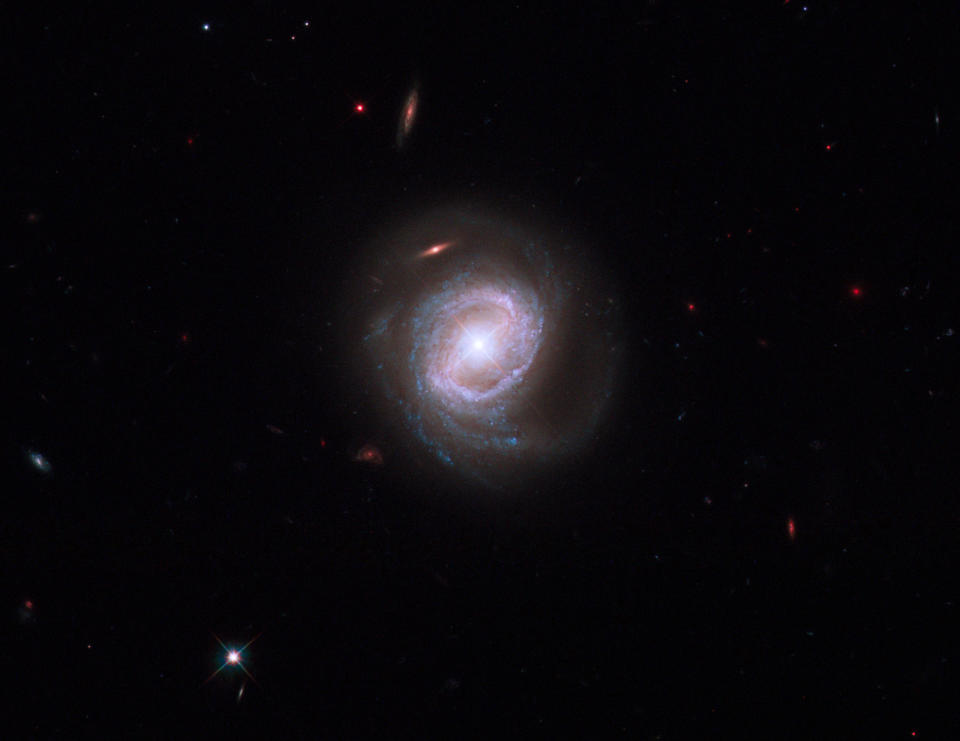Astronomers have spotted a supermassive black hole throwing a galactic-scale tantrum as it feeds, figuratively “turning the table” and cutting off the host system’s gas supply needed to give birth to stars.
The table-turning behavior comes in the form of an ultra-fast wind emanating from the light-snacking supermassive black hole, which resides in a distinctly average galaxy. The galaxy is called Markarian 817 (Mrk 817) and is located 430 million light years away in the constellation Draco; the situation in question was detected by the European Space Agency’s (ESA) XMM-Newton space telescope.
Supermassive black holes with masses millions or even billions of times that of the Sun are thought to reside at the hearts of all galaxies. In some cases, however, these cosmic titans are surrounded by disks of gas and dust, called accretion disks, that “feed” them.
When this is the case, the immense gravity of these black holes overheats the gaseous and dusty matter, causing it to glow. In addition, powerful magnetic fields direct matter that does not ultimately end up in the black hole to the poles, where it is blown out at speeds close to light. As a result of this turbulent activity, these regions, known as ‘active galactic nuclei’ or AGNs, can often outshine the combined light of every star in the galaxies around them.
Related: Astronomers witness eighteen ravenous black holes tearing and devouring stars
In some cases, supermassive black holes powering AGN exhibit even more drastic behavior, upending their entire cosmic dinner table by throwing gas in surrounding accretion disks outward in all directions. This results in ‘ultrafast black hole winds’.
When this happens, the tantrum-throwing black hole not only deprives itself of gas to feed on, but also drives gas away from its host galaxy, stopping the birth of stars over a vast region.
Previously, astronomers had only seen these ultrafast black hole winds coming from extremely bright AGNs with furiously feeding black holes.
‘This is the first time we have seen ultrafast winds emitted from the active galactic nuclei (AGN) disk around a supermassive black hole, which is growing significantly slower than the rate at which we expect the activation of such winds’ Elias Kammoun, team member and postdoctoral fellow researcher at Sapienza University of Rome, told Space.com.
Before this discovery, Kammoun said, it was generally accepted that the generation of ultrafast winds only occurred in episodes when gas flowed through the supermassive black hole at a very high speed.
“In this regime, a large amount of energy is released and radiated away, which is a key factor in driving disk winds,” he continued. ‘Several pieces of evidence have shown that the activity of central black holes plays a key role in reshaping the host galaxy and influencing its evolution, what we call AGN feedback. However, the conditions under which this feedback can be activated are still not very clear.
“Discovering ultrafast winds in a moderately accreting source will make us rethink the way we observe winds in AGNs.”
The black hole fell silent before the table was turned
Mrk 817 had let astronomers know that something dramatic was on the horizon when its AGN became extremely quiet. Normally you would expect it to emit high-energy light, such as X-rays.
Miranda Zak, a University of Michigan graduate student and team leader, first noticed the strange interruption at NASA’s Swift Observatory, and later tracked the more sensitive XMM-Newton. Ultimately, Zak discovered that ultrafast winds coming from the accretion disk at the heart of Mrk 817 absorbed X-rays, effectively masking any signals coming from the central supermassive black hole.
Further analysis of the X-ray images of this AGN then showed that the central region of Mrk 817 did not just emit a single cloud of gas, but blew a large storm across the accretion disk. And according to their observations, they can still see it happening. These winds can last for hundreds of days and are made up of at least three separate components, each moving at a fraction of the speed of light.

“Identifying disk winds in supermassive black holes accreting at normal rates, such as Mrk 817, was not expected at all,” Kammoun said. ‘The phase with a high accretion rate would be a short phase in the life of the supermassive black hole. On the contrary, Mrk 817’s accretion phase can last much longer due to its moderate speed.’
He added that this has two important implications for our understanding of supermassive black hole feeding, and the AGNs that power them.
First, this implies that even light-feeding supermassive black holes can expel winds powerful enough to reshape their host galaxies; they also appear to have a lifespan long enough to allow such actions.
Second, if ultrafast winds can arise from regions around moderately accreting black holes, such winds are likely more common than astronomers currently suspect. So scientists believe that these winds likely formed many different galaxies, including some of which we are already aware of.
Related stories:
— Black hole announces itself to astronomers by violently tearing apart a star
– Record breaker! The newly discovered black hole is closest to Earth
— NASA X-ray observatory shows how black holes swallow stars and spit out matter
The discovery of long-lasting winds from a silent black hole could also one day help answer an interesting question: why do some galaxies like the Milky Way with silent, light-feeding black holes appear to have large, vast regions at their heart where stars only exist in very small numbers?
“There is still a lot to learn about the Mrk 817 in particular and AGN is going broader,” Kammoun said. “This discovery changes the way we look at AGNs. It will be critical to know how many of the moderately accreting sources actually launch winds. This will help us better understand how common they are.
“I believe this is just the tip of the iceberg!”
The team’s research was published Thursday (Feb. 1) in the Astrophysical Journal.